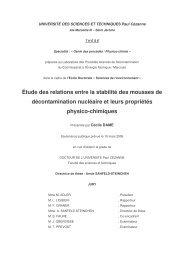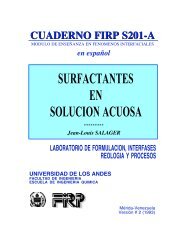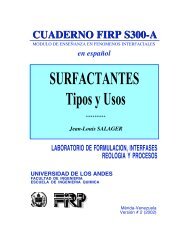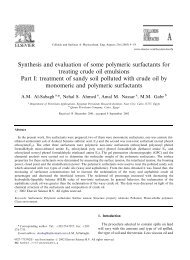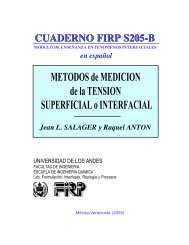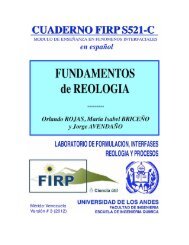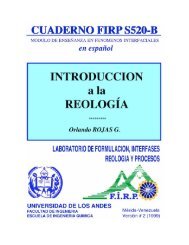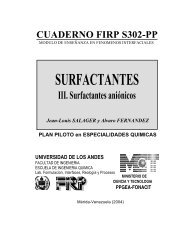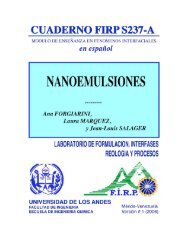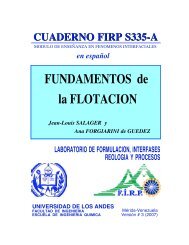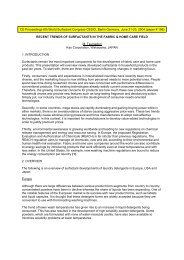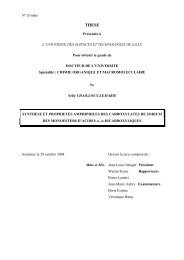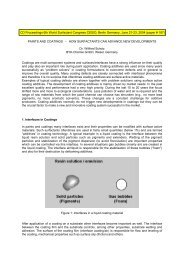Solubilization-emulsification mechanisms of detergency
Solubilization-emulsification mechanisms of detergency
Solubilization-emulsification mechanisms of detergency
Create successful ePaper yourself
Turn your PDF publications into a flip-book with our unique Google optimized e-Paper software.
C.A. Miller and K.H. Raney/Colloids Surfaces A: Physicochem. Eng. Aspects 74 (1993) 169-215 193<br />
Fig. 30. Schematic illustration <strong>of</strong> contacting<br />
experiment in which a small oil drop is injected into<br />
an aqueous surfactant solution.<br />
velops later in the experiment when the oil<br />
composition becomes suitable. Examples <strong>of</strong><br />
such behavior are discussed below.<br />
An oil drop-contacting technique was<br />
developed in which the water-to-oil ratio is<br />
large, as in practical washing situations. As<br />
shown in Fig. 30, a drop <strong>of</strong> oil, usually some<br />
10-100 mm in diameter, is injected into a<br />
horizontal rectangular glass cell by means <strong>of</strong> a<br />
very thin hypodermic needle. The cell, which is<br />
400 Rm thick, is inside a thermal stage modified<br />
to enable the drop to be observed by<br />
videomicroscopy from the moment <strong>of</strong> injection<br />
[24,60]. Since the drop must be viewed through<br />
the surfactant solution in which it is immersed,<br />
this technique works best when the surfactant<br />
solution is below its cloud point temperature.<br />
However, some experiments have been<br />
successfully carried out in which the initial<br />
surfactant solution was a dispersion <strong>of</strong> the<br />
lamellar liquid crystal in water, as discussed<br />
below. It is noteworthy that no similar limitation<br />
exists for the vertical cell technique, and indeed<br />
almost all <strong>of</strong> the experiments described above<br />
for non-polar oils were conducted above the<br />
cloud point temperature.<br />
7. 1. Experiments with surfactant mixtures and<br />
nonPolar oils<br />
Mixtures <strong>of</strong> anionic and non-ionic surfactants<br />
are now almost universally used in liquid<br />
detergents for laundry applications since they<br />
are more effective than anionics alone for<br />
washing synthetic fabrics at low temperatures.<br />
The oil dropcontacting technique was used to<br />
determine whether an intermediate<br />
microemulsion phase would form near the PIT<br />
for these mixed surfactant systems with<br />
hydrocarbon soils [24] in a manner similar to<br />
that described above for pure non-ionic<br />
surfactants with the vertical cell technique.<br />
The pure non-ionic surfactant C12E3 and the<br />
commercial anionic surfactant Neodol 23-3S<br />
were used in this study, i.e. the same<br />
combination as discussed above in the phase<br />
behavior section. The use <strong>of</strong> a commercial<br />
mixture rather than a pure anionic surfactant had<br />
minimal effect on the differential partitioning<br />
since all the individual anionic species in the<br />
mixture had very low solubilities in<br />
n-hexadecane, the hydrocarbon used. Because<br />
the volume <strong>of</strong> the oil drop injected was small, it<br />
dissolved little non-ionic surfactant, and the<br />
relevant PIT was that for which the surfactant<br />
composition Ssn in the films within the<br />
microemulsion phase was the same as the<br />
overall surfactant composition in the system.<br />
Data on Ssn for this system when the aqueous<br />
phase contains 1 wt.% NaCl are given in Fig. 7.<br />
As may be seen from Fig. 4, the initial washing<br />
bath, i.e. the oilfree mixture <strong>of</strong> the surfactant<br />
and a 1 wt.% NaCl solution, forms a dispersion<br />
<strong>of</strong> the lamellar liquid crystal in brine for<br />
surfactant compositions equal to the relevant<br />
values <strong>of</strong> Ssn. Contacting experiments were conducted for a<br />
surfactant mixture containing 78 wt.% <strong>of</strong> the<br />
nonionic surfactant [24]. According to Fig. 4,<br />
the relevant PIT is 30ºC. At 25ºC, no<br />
intermediate phase was observed and the drop<br />
diameter did not decrease appreciably with time.<br />
Thus, solubilization <strong>of</strong> hydrocarbon by the<br />
liquid crystalline phase was very slow at this<br />
temperature below the PIT. At 30ºC, an<br />
intermediate microemulsion phase was<br />
observed. Its volume continued to increase until<br />
the oil phase disappeared. At 40ºC, the drop<br />
diameter increased with time, the expected<br />
behavior above the PIT as the oil phase takes up<br />
surfactant and water. The liquid crystalline<br />
particles surrounding the drop made it difficult<br />
to discern whether spontaneous <strong>emulsification</strong>



